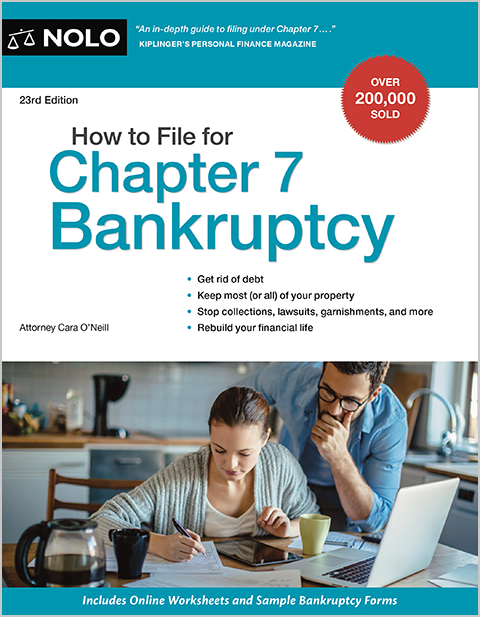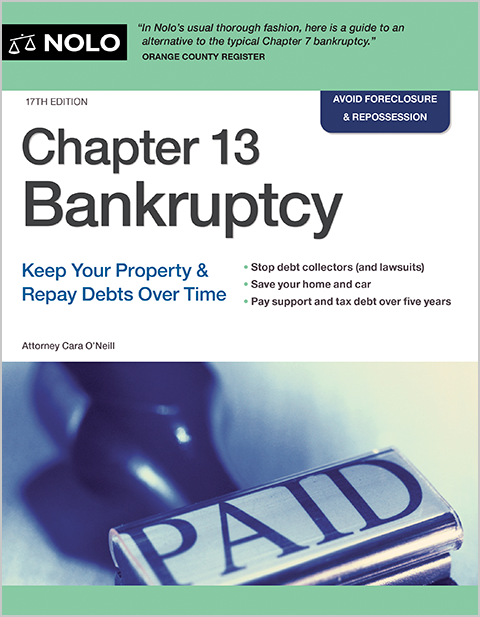Find out when a car loan lender can repossess your car during Chapter 13 bankruptcy and whether you can get it back if the repossession happened before you filed.
When you file for Chapter 13 bankruptcy, it's common to wonder if your car is safe from repossession, or if you recently lost it to repossession, whether Chapter 13 bankruptcy can help you regain it. Read on for the answers about what happens to your car and car loan in Chapter 13 bankruptcy. For more, see Your Car in Chapter 13 Bankruptcy.
The Automatic Stay Stops Car Repossession
In Chapter 13 bankruptcy, the court issues an order called the "automatic stay" prohibiting debt collection attempts. The stay applies to most, but not all, creditors and debt types.
For instance, the stay will stop collections for credit card debt and other loans. It will also prevent a foreclosure sale and a lender from repossessing your car.
However, the stay won't stop criminal actions, child custody and visitation proceedings, and, depending on your state law, certain eviction proceedings. Bankruptcy also doesn't stop some lawsuits.
In some cases, the lender can ask the bankruptcy court to remove the stay to allow the lender to proceed with collection actions. Learn when a lender will ask the court to lift the automatic stay.
Chapter 13 Bankruptcy Helps You Keep Your Car
Here's how the automatic stay protects you in two different repossession situations.
You Still Have the Car When You File for Bankruptcy
If the lender hasn't repossessed your car when you file for bankruptcy, the automatic stay will prevent the lender from repossessing it until the bankruptcy judge approves your Chapter 13 repayment plan. If your repayment plan repays any "arrearages" or missed car loan payments, the lender can't repossess your car during your bankruptcy or after it concludes, assuming you stay current on your payments.
The Lender Repossessed the Car Before You Filed for Bankruptcy
In some cases, if the lender repossesses your car shortly before you file for Chapter 13 bankruptcy, you might be able to get the car back. In your repayment plan, you'll need to provide for the arrearage payment and be able to continue making your monthly payments. If your car has been repossessed and you plan to file for Chapter 13 bankruptcy, contact an attorney immediately. To learn more, see My lender repossessed my car right before bankruptcy. Can I get it back?
When the Stay Might Not Protect You
The stay lifts by operation of law, which is another way to say "automatically." For instance, the stay will go away if you:
- file a Chapter 13 bankruptcy shortly after the court dismisses a previously filed Chapter 13 case (the stay will last for 30 days only unless you file and win a motion requesting additional time), or
- reject a personal property lease, such as for a car or equipment (the automatic stay will lift on the rejection date).
Additionally, you must make "adequate protection" payments from the time you file for bankruptcy until your plan is approved. These payments cover the depreciation of your car during this period, so you should plan to keep making your car payments until the court confirms your plan. Usually, adequate protection payments are equal to the amount of your car payment.
A creditor can ask the court to "lift" or remove the automatic stay to continue collection proceedings during a bankruptcy case. A lender who can show that it stands to lose money—for instance, you don't make adequate protection payments or stop making your car payments during your case—will have a good chance of winning such a motion.
Learn more about your car in Chapter 13 bankruptcy.
Other Chapter 13 Benefits: Reducing a Car Payment
If you're worried about your car getting repossessed, you likely can't afford the payment. If you owe more than the vehicle is worth, Chapter 13 bankruptcy can help.
If the loan balance on the car (or boat, storage building, furniture, jewelry, vacation home, and similar property) meets certain conditions (more below), you can reduce it to the property's value. You can also lower a high interest rate to a more affordable amount. Any remaining amount is treated as unsecured and will only be paid if you have room in your budget.
The ability to alter loan terms is called a cramdown, and it's available for just about any type of loan secured by the property except for the mortgage on your principal home or a recently purchased item (more limitations below).
Example. Jean owes $10,000 on a Prius she bought three years ago, but it's only worth $8,000. In Chapter 13 bankruptcy, a cramdown will allow Jean to reduce the amount she must pay for the car loan to $8,000.
The bankruptcy code also allows you to reduce a high interest rate. The creditor is entitled to receive the prime interest rate plus 1 or 2 points. (Most courts accept the prime rate published by the Wall Street Journal.) For instance, if the current rate is 4%, most bankruptcy courts would approve a cramdown to around 6% (this will change as rates rise).
Limitations on Car Cramdowns
The cramdown option isn't limitless. It doesn't apply to new car loans (and other types of property) and doesn't survive a Chapter 13 case that is dismissed rather than discharged.
- No cramdown for a recent property purchase. Cramdown isn't available on a loan used to buy a vehicle during the 910 days before filing the bankruptcy case. You can cram down car title loans that weren't used to purchase the vehicle even if that title loan was taken out within the 910 days (for instance, you used the car as collateral for another financed purchase).
- No cramdown in a dismissed Chapter 13 case. You'll benefit from the reduced balance and interest rate only if you complete your Chapter 13 plan. If the case gets dismissed, the loan will revert to its original terms and the creditor will have the right to collect the total amount owed at the higher interest rate.
Need More Bankruptcy Help?
Did you know Nolo has made the law easy for over fifty years? It's true, and we want to ensure you find what you need. Below you'll find more articles explaining how bankruptcy works. And don't forget that our bankruptcy homepage is the best place to start if you have other questions!
|
Our Editor's Picks for You |
|
|
More Like This |
Debts That Must Be Paid in Chapter 13 |
|
What to Consider Before Filing Bankruptcy |
Preparing for Bankruptcy: What to Do With Bank Accounts, Automatic Payments, and Utility Deposits |
|
Helpful Bankruptcy Sites |
We wholeheartedly encourage research and learning, but online articles can't address all bankruptcy issues or the facts of your case. The best way to protect your assets in bankruptcy is by hiring a local bankruptcy lawyer.

